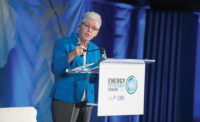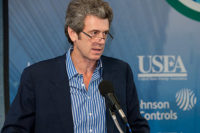WASHINGTON — Energy efficiency is driving innovation in policies, practices, and technologies and is becoming much more significant to our economy, noted speakers at the 2016 Energy Efficiency Forum, held June 23 at the National Press Club in Washington, District of Columbia, cosponsored by Johnson Controls Inc. and the U.S. Energy Association.
The forum also included a review of the 2016 Energy Efficiency Indicator Survey conducted by Johnson Controls. (See sidebar on Page 26.)
A PROVEN STRATEGY
Keynote speaker Gina McCarthy, administrator of the U.S. Environmental Protection Agency (EPA), stated, “Energy efficiency is such an incredibly proven strategy not just to protect the environment but also to grow the economy and to create jobs.
“Today, an additional 1.9 million Americans are employed, either in whole or in part, in energy efficiency. And the U.S. Department of Energy [DOE] projects that more than a quarter million new hires will occur in 2016 alone.
“So if someone’s making that old, tired argument that what’s good for the environment is bad for the economy, can you remind them that is so yesterday?”
McCarthy added, “Since the EPA’s Energy Star program launched in 1992, we’ve been able to leverage energy efficiency to prevent 2.7 billion metric tons of greenhouse gas emissions, and we’ve saved families and businesses $430 billion on their utility bills.
“Energy efficiency is a smart bet for every family and business,” McCarthy said.
At the legislative level, U.S. Sen. Maria Cantwell, D-Washington, discussed the new energy-efficiency bill in Congress, which addresses smart buildings and is looking to accelerate the adoption of smart building technologies. “The new smart building focus has enormous potential for energy savings, high-paying jobs, and the stimulation of economic growth,” she said.
“The trend toward smarter and integrated is, I believe, a game changer.”
SEEKING BALANCE
Ralph Izzo, chairman, president, and CEO of utility Public Service Enterprise Group (PSEG), highlighted the importance of balancing energy regulations. “There are four winners in an intelligent, balanced energy-efficiency regulation,” Izzo said. “First of all, consumers can be winners because energy efficiency can reduce bills. Secondly, suppliers can be winners because I would argue the utility would be the best sales channel a manufacturer of equipment or software applications or management systems would ever stumble upon. Third, the environment would be a winner because consuming one less unit of electricity or natural gas would mean one less bit of emissions to our air and water. And, lastly, utilities can be winners if the regulation is such that I am indifferent to making that investment in an efficient light bulb or copper cable. The challenge is being balanced. If any of these constituencies thinks they are all that matters, we will make losers of the others and will not be able to go forward.”
The forum also brought together mayors and former mayors from across the U.S. to discuss a variety of energy-saving measures their cities are taking. The mayor’s panel agreed cities like theirs play key roles in U.S. leadership on climate change. “The local level, I think, is where we are going to find the answers, share them, emulate what is successful, avoid what is not successful, and come to a solution,” said Greg Nickels, former mayor of Seattle.
David Nemtzow, acting director of the DOE’s Building Technologies Office (BTO), noted his office’s Better Buildings Program is working with commercial, industrial, and multifamily partners to increase energy efficiency by 20 percent over the next decade. The DOE and its partners then share their solutions. “The innovative solutions we work on need to be shared,” he said. “It’s essential to energy efficiency.
“It’s important that we work together and share our results, Nemtzow emphasized. “One of the signs of leadership is to know that you don’t know everything.”
SIDEBAR: Interest, Investment in Efficiency Growing
The 2016 Johnson Controls Energy Efficiency Indicator (EEI) survey of more than 1,200 facility and energy management executives in the U.S., Brazil, China, Germany, and India shows interest and investment in energy efficiency are at an all-time high.
Fifty percent of respondents said their organizations are paying more attention to energy efficiency today than they did a year ago, with 72 percent anticipating increased investments in energy efficiency and renewable energy over the next 12 months. By comparison, 37 percent of global respondents in 2013 reported paying more attention to energy efficiency and 42 percent planned to increase investments.
Although cost reduction remains the primary driver, organizations are also increasingly considering energy security, customer and employee attraction, greenhouse gas reduction, enhanced reputation, government policy, and investor expectations when making investment decisions.
As in the past, respondents reported a lack of funding, insufficient payback, savings uncertainty, and a lack of technical expertise as the most significant barriers to investment. According to the survey, organizations operating larger portfolios of buildings are more likely to use internal capital for investments and are twice as likely to secure external financing or use energy services agreements to make energy-efficiency improvements.
Organizations with the majority of their facilities located in urban areas are more likely to invest in smart building and smart energy technology. Sixty-four percent of organizations in urban areas have invested in building management systems, while more than 50 percent have invested in the integration of building management systems with lighting, security, life safety, or other building systems. In addition, 39 percent of organizations in urban areas have invested in on-site renewable energy and 24 percent in nonrenewable distributed generation.
The most frequent energy-efficiency measures implemented last year were HVAC improvements, energy-education programs, building controls upgrades, building systems integration, on-site renewable energy, and water efficiency improvements.
Resilience is becoming an important driver, with 82 percent of organizations reporting the ability to maintain critical operations during severe weather events or extended power outages is extremely important when considering future infrastructure investments.
Publication date: 8/22/2016
Want more HVAC industry news and information? Join The NEWS on Facebook, Twitter, and LinkedIn today!








